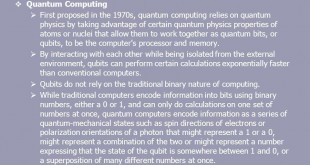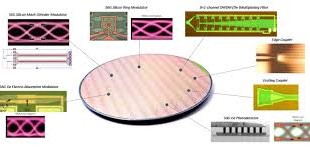Quantum technology (QT) applies quantum mechanical properties such as quantum entanglement, quantum superposition, and No-cloning theorem to quantum systems such as atoms, ions, electrons, photons, or molecules. Quantum bit is the basic unit of quantum information. Whereas in a classical system, a bit is either in one state or the another. However, quantum qubits can exist in large number of states simultaneously, property called Superposition.
Quantum entanglement is a phenomenon where entangled particles can stay connected in the sense that the actions performed on one of the particles affects the other no matter what’s the distance between them. No-cloning theorem tells us that quantum information (qubit) cannot be copied.
Quantum Sensing exploit high sensitivity of quantum systems to external disturbances to develop highly sensitive sensors. They can measure Quantities such as time, magnetic and electrical fields, inertial forces, temperature, and many others. They employ quantum systems such as NV centers, atomic vapors, Rydberg atoms, and trapped ions.
Current atomic clocks based on Cesium or Rubidium loses just a second in 100 million years. These next generation Quantum clocks based on single atoms will lose only a second in a billion years. Quantum Gravimeters can measure gravity with greater sensitivity and reliability while more robust against external noise sources. Quantum navigation could be far more accurate than using current accelerometers and gyroscopes and will provide backup to GPS, if GPS fails or navigation in places where GPS is not available.
Quantum imaging exploits quantum entanglement of the electromagnetic field to image objects with a high resolution under low light levels, or in the presence of strong background illumination. It has applications in 3D cameras, behind the corner cameras, quantum radar and lidar.
New developments in single photon detectors offer unprecedented levels of sensitivity in combination with precision timing (less than one nanosecond). These detectors can be utilised in combination with short pulse lasers to create quantum-enhanced imaging systems that rely on time-correlations between the emitted laser pulse and detection event.
These imaging systems can be utilised for enhanced performance in obscuring environments and through scattering medium such as underwater or through smoke. The precision timing can enable mm-depth resolution at range. Using time-gated mechanisms it is possible to achieve enhanced sensitivity in spectroscopic applications where fluorescence decay times can be isolated from other absorption mechanisms.
Quantum Lidar
Radar and its optical counterpart, lidar, are well established and widely used technologies. The first is typically exploited for long-range detection, while lidar, operating at visible to near infrared wavelengths, offers improved resolution yet at a shorter distance. Proof of principle results show the possibility to exploit quantum detection and illumination (e.g. entangled photons) to increase radar/lidar resolution and sensitivity.
The phenomenon of quantum entanglement has applications leading to devices and systems having capabilities
unperceived till recently. One of the applications of Quantum entanglement phenomenon is that it can lead to ‘Quantum Lidar’, which has a resolution of more than ten times that of classical Lidars. A Quantumly-entangled Lidar can also detect stealth military objects like aircrafts, ships, submarines etc. Stealth objects are designed to reflect signals away from the radar/lidar, typically by using rounded surfaces and avoiding anything that might form a partial corner reflector. The stealth property can also be achieved to a large extent by coating the object with the Radar Absorbing Material (RAM). This so reduces the amount of signal returned to the radar’s receiver that the target is (ideally) lost in the thermal background noise. Quantum lidar capabilities have recently been demonstrated by China and then followed by Canada.
Quantum Radar Technology
Quantum Lidar is a future technology that can mean different things to different people. To some it means detection and identification of classical-type lidar signals reflected from an illuminated target at or near the single photon level. This is facilitated by advances in semiconductor detector technology that allow highly efficient photocounting. To others it is more stringent, requiring exploitation of covertness associated with being essentially undetectable by the target in a thermal background, whilst allowing the lidar operator to filter her own signal from this noise
beams one half of the entangled pair outwards, and monitors the corresponding effects on their entangled
partners. If the beamed particles bump into, say, a stealth fighter, the effect on the beamed photon would be
visible on the un-beamed partner photon as well. Then the photons which register a ‘ping’ are sorted out from
the unaffected photons to form a sort of radar image.
split it in half. One half, the “signal beam”, goes through a conversion to microwave frequencies in a way that
preserves the original quantum state. The microwave signal is then sent and received as in a normal radar
system. When the reflected signal is received it is converted back into photons and compared with the other
half of the original entangled beam, the “idler beam”.
to the target objects and back, enough quantum correlations will still remain between the reflected-signal and
the idler beams. Using a suitable quantum detection scheme, the system can pick out just those photons that
were originally sent by the radar, completely filtering out any other sources.
part of their quantum receiver. This is not far from the current experimental conditions: photon collection
efficiencies from optical cavities can be very high (over 74% ), loss at the beam splitter can be extremely low,
and photodetection can be extremely efficient at optical wavelengths. Thus the main source of loss may come
from the optical storage of the idler mode, to be preserved during the signal roundtrip time. This is not an issue
for short-range applications but, for long-range tasks, the idler loss must remain below 3 dB, otherwise the
advantage of the phase-conjugating quantum receiver is lost. While using a good quantum memory (e.g., a
rare-earth doped-crystal) would solve the problem, the practical solution of storing the idler into an opticalfiber delay line would restrict the maximum range of the quantum radar to about 11.25 km in free-space
(assuming a fiber loss of 0.2 dB/km and fiber propagation speed equal to 2c/3, where c is vacuum light-speed).
Expanding lidar resolution through quantum technology
Lidar uses laser pulses to acquire 3D information about a scene or object and is typically used for imaging large objects such as buildings, vehicles, people and other structures due to its limited depth resolution. Researchers from the University of Glasgow have developed a quantum-inspired technique that can be used to provide a higher depth resolution for lidar imaging.
In the Optica Publishing Group journal Optics Express, Lyons and first author Robbie Murray describe the new technique, which they call imaging two-photon interference lidar. They show that it can distinguish reflective surfaces less than 2 millimeters apart and create high-resolution 3D images with micron-scale resolution.
“This work could lead to much higher resolution 3D imaging than is possible now, which could be useful for facial recognition and tracking applications that involve small features,” said Lyons. “For practical use, conventional lidar could be used to get a rough idea of where an object might be and then the object could be carefully measured with our method.”
The new technique uses “quantum inspired” interferometry, which extracts information from the way that two light beams interfere with each other. Entangled pairs of photons—or quantum light—are often used for this type of interferometry, but approaches based on photon entanglement tend to perform poorly in situations with high levels of light loss, which is almost always the case for lidar. To overcome this problem, the researchers applied what they’ve learned from quantum sensing to classical (non-quantum) light.
“With quantum entangled photons, only so many photon pairs per unit time can be generated before the setup becomes very technically demanding,” said Lyons. “These problems don’t exist with classical light, and it is possible to get around the high losses by turning up the laser power.”
When two identical photons meet at a beam splitter at the same time they will always stick together, or become entangled, and leave in the same direction. Classical light shows the same behavior but to a lesser degree—most of the time classical photons go in the same direction. The researchers used this property of classical light to very precisely time the arrival of one photon by looking at when two photons simultaneously arrive at detectors.
Enhancing depth resolution
“The time information gives us the ability to perform depth ranging by sending one of those photons out onto the 3D scene and then timing how long it takes for that photon to come back,” said Lyons. “Thus, two-photon interference lidar works much like conventional lidar but allows us to more precisely time how long it takes for that photon to reach the detector, which directly translates into greater depth resolution.”
The researchers demonstrated the high depth resolution of two-photon interference lidar by using it to detect the two reflective surfaces of a piece of glass about 2 millimeters thick. Traditional lidar wouldn’t be able to distinguish these two surfaces, but the researchers were able to clearly measure the two surfaces. They also used the new method to create a detailed 3D map of a 20-pence coin with 7-micron depth resolution. This shows that the method could capture the level of detail necessary to differentiate key facial features or other differences between people.
Two-photon interference lidar also works very well at the single-photon level, which could enhance more complex imaging approaches used for non-line-of-sight imaging or imaging through highly scattering media.
Currently, acquiring the images takes a long time because it requires scanning across all three spatial dimensions. The researchers are working to make this process faster by reducing the amount of scanning necessary to acquire 3D information.
– This press release was originally published on the Optica website
References and Resources also include:
https://ui.adsabs.harvard.edu/abs/2020SPIE11502E..04B/abstract
 International Defense Security & Technology Your trusted Source for News, Research and Analysis
International Defense Security & Technology Your trusted Source for News, Research and Analysis

